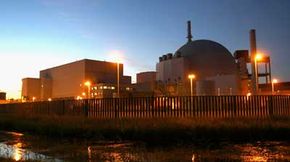Outside a Nuclear Power Plant
Once you get past the reactor itself, there's very little difference between a nuclear power plant and a coal-fired or oil-fired power plant, except for the source of the heat used to create steam. But as that source can emit harmful levels of radiation, extra precautions are required.
A concrete liner typically houses the reactor's pressure vessel and acts as a radiation shield. That liner, in turn, is housed within a much larger steel containment vessel. This vessel contains the reactor core, as well as the equipment plant workers use to refuel and maintain the reactor. The steel containment vessel serves as a barrier to prevent leakage of any radioactive gases or fluids from the plant [source: Nuclear-power.net].
Advertisement
An outer concrete building serves as the final layer, protecting the steel containment vessel. This concrete structure is designed to be strong enough to survive the kind of massive damage that might result from earthquakes or a crashing jet airliner [source: Wald].
These secondary containment structures are necessary to prevent the escape of radiation/radioactive steam in the event of an accident. The absence of secondary containment structures in Russian nuclear power plants allowed radioactive material to escape in Chernobyl [source: Salisbury].
Workers in the control room at the nuclear power plant can monitor the nuclear reactor and take action if something goes wrong. Nuclear facilities also typically feature security perimeters and added personnel to help protect sensitive materials.
As you probably know, nuclear power has its share of critics, as well as its supporters. On the next page, we'll take a quick look at some of the pros and cons of splitting an atom to keep everyone's TVs and toasters running.
